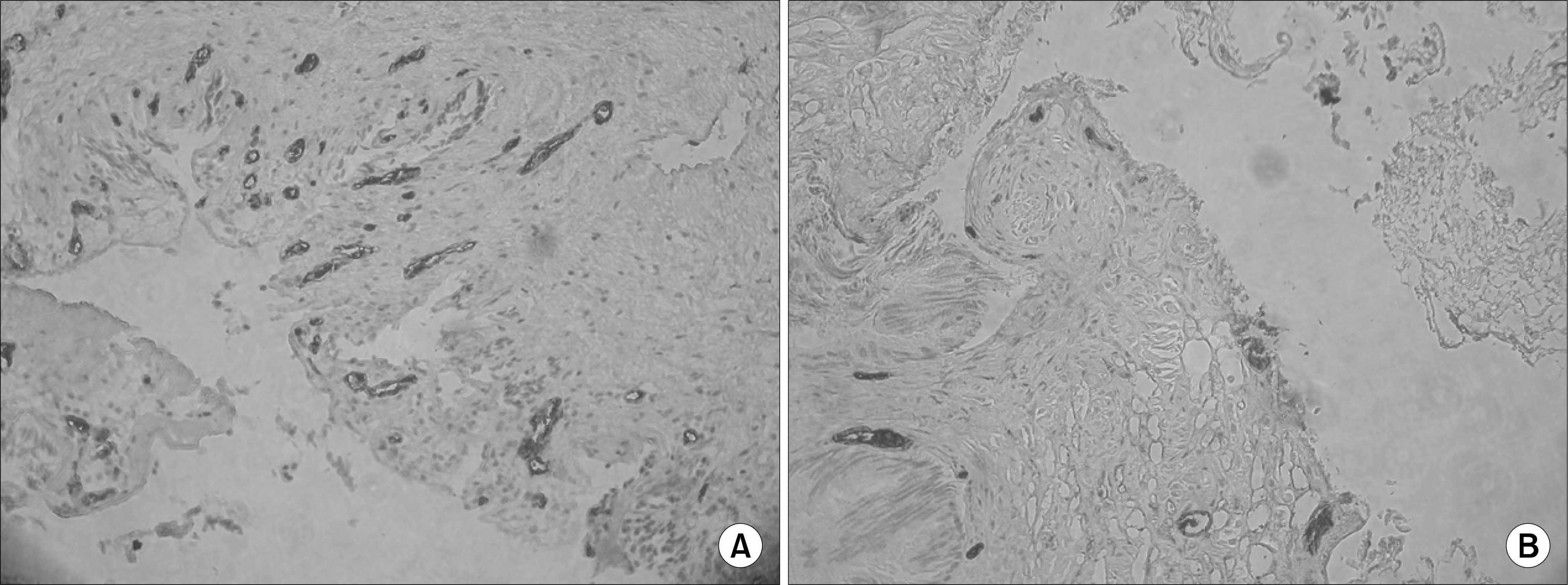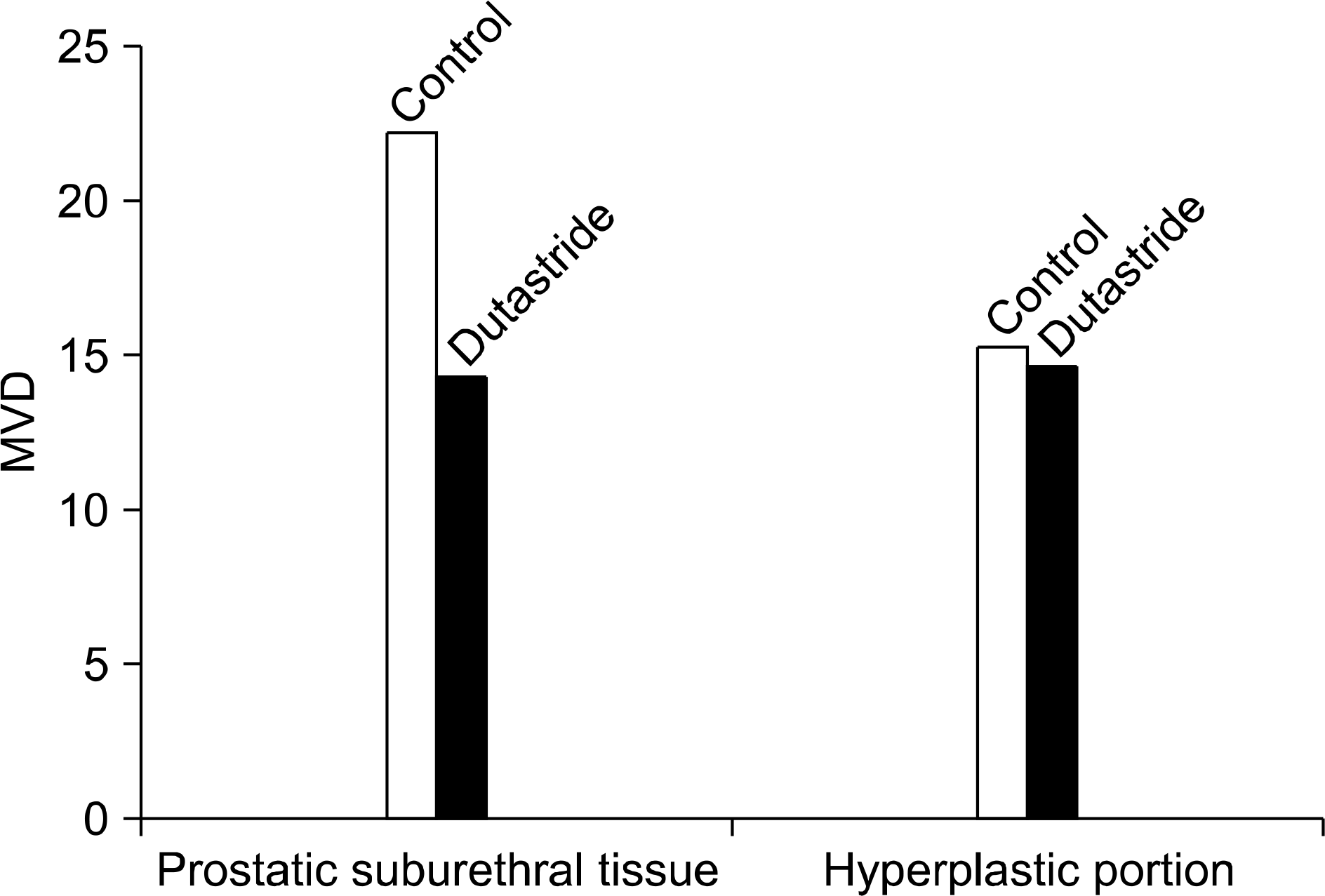Abstract
Purpose
Several studies have shown that finasteride limits hematuria in patients with benign prostatic hyperplasia (BPH). However, there are few reports addressing dutasteride therapy. We evaluated the effect of dutasteride on intraoperative blood loss and on microvessel density (MVD) in patients with BPH.
Materials and Methods
We studied 39 patients with BPH who underwent transurethral resection of the prostate (TURP). Group I included 22 patients who received dutasteride 0.5mg daily for 2 weeks preoperatively, and group II included 17 patients who did not. Blood loss was evaluated by comparing preoperative and postoperative hemoglobin. Sections from the prostatic suburothelium and hyperplastic prostate were individually stained for CD 34. MVD was calculated by counting the number of positively stained blood vessels in 5 random high power fields. There were no significant differences between the groups in terms of age, total prostatic volume, resected prostatic weight, or prostate-specific antigen (PSA).
Results
The mean MVD in the suburethral portion in dutasteride-treated patients was significantly lower than that seen in untreated patients (14.47 versus 22.19 vessels per high power field, p=0.026). In nodular hyperplasia, there was no significant difference in MVD between the two group (14.72 versus 15.24 vessels per high power field, p=0.801).
REFERENCES
1. Guess HA, Arrighi HM, Metter EJ, Fozard JL. Cumulative prevalence of prostatism matches the autopsy prevalence of benign prostatic hyperplasia. Prostate. 1990; 17:241–6.

2. Mebust WK, Holtgrewe HL, Cockett AT, Peters PC. Transurethral prostatectomy: immediate and postoperative complications. A cooperative study of 13 participating institutions evaluating 3,885 patients. J Urol. 1989; 141:243–7.
3. Uchida T, Ohori M, Soh S, Sato T, Iwamura M, Ao T, et al. Factors influencing morbidity in patients undergoing transurethral resection of the prostate. Urology. 1999; 53:98–105.

4. Madersbacher S, Marberger M. Is transurethral resection of the prostate still justified? BJU Int. 1999; 83:227–37.

5. Hunter DJ, Berra-Unamuno A, Martin-Gordo A. Prevalence of urinary symptoms and other urological conditions in Spanish men 50 years old or older. J Urol. 1996; 155:1965–70.

6. Levine AC, Liu XH, Greenberg PD, Eliashvili M, Schiff JD, Aaronson SA, et al. Androgens induce the expression of vascular endothelial growth factor in human fetal prostatic fibroblasts. Endocrinology. 1998; 139:4672–8.
7. Pareek G, Shevchuk M, Armenakas NA, Vasjovic L, Hochberg DA, Basillote JB, et al. The effect of finasteride on the expression of vascular endothelial growth factor and microvessel density: a possible mechanism for decreased prostatic bleeding in treated patients. J Urol. 2003; 169:20–3.

8. Donohue JF, Sharma H, Abraham R, Natalwala S, Thomas DR, Foster MC. Transurethral prostate resection and bleeding: a randomized, placebo controlled trial of role of finasteride for decreasing operative blood loss. J Urol. 2002; 168:2024–6.

9. Clark RV, Hermann DJ, Cunningham GR, Wilson TH, Morrill BB, Hobbs S. Marked suppression of dihydrotestosterone in men with benign prostatic hyperplasia by dutasteride, a dual 5alpha-reductase inhibitor. J Clin Endocrinol Metab. 2004; 89:2179–84.
10. Cha WH, Jang TJ, Lee KS. Expression of survivin and Bcl-2 in benign prostatic hyperplasia treated with a5-alpha-reductase inhibitor. Korean J Urol. 2008; 49:242–7.
11. Chang HS, Park CH, Kim CI. Comparison of the long term effect of alpha-blocker only and 5-alpha reductase inhibitor combination treatment on acute urinary retention and prostatic surgery for patients with benign prostatic hyperplasia. Korean J Urol. 2006; 47:7–12.

12. Miller MI, Puchner PJ. Effects of finasteride on hematuria associated with benign prostatic hyperplasia: longterm followup. Urology. 1998; 51:237–40.

13. Kashif KM, Foley SJ, Basketter V, Holmes SA. Haematuria associated with BPH-Natural history and a new treatment option. Prostate Cancer Prostatic Dis. 1998; 1:154–6.

14. Marshall S, Narayan P. Treatment of prostatic bleeding: suppression of angiogenesis by androgen deprivation. J Urol. 1993; 149:1553–4.

15. Lekas E, Bergh A, Damber JE. Effects of finasteride and bicalutamide on prostatic blood flow in the rat. BJU Int. 2000; 85:962–5.
16. Hochberg DA, Basillote JB, Armenakas NA, Vasovic L, Shevchuk M, Pareek G, et al. Decreased suburethral prostatic microvessel density in finasteride treated prostates: a possible mechanism for reduced bleeding in benign prostatic hyperplasia. J Urol. 2002; 167:1731–3.

17. Donohue JF, Hayne D, Karnik U, Thomas DR, Foster MC. Randomized, placebo-controlled trial showing that finasteride reduces prostatic vascularity rapidly within 2 weeks. BJU Int. 2005; 96:1319–22.

18. Sandfeldt L, Bailey DM, Hahn RG. Blood loss during transurethral resection of the prostate after 3 months of treatment with finasteride. Urology. 2001; 58:972–6.

19. Bartsch G, Rittmaster RS, Klocker H. Dihydrotestosterone and the concept of 5alpha-reductase inhibition in human benign prostatic hyperplasia. Eur Urol. 2000; 37:367–80.
Fig. 2.
Immunohistochemistry of CD34-stained sections demonstrates suburethral prostatic microvessel density in control (A) and in dutasteride-treated (B) prostates. Reduced from x200.

Table 1.
Patients characteristics




 PDF
PDF ePub
ePub Citation
Citation Print
Print



 XML Download
XML Download